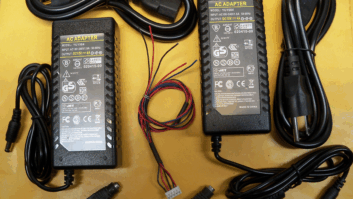Our recent stories about technically challenged operators generated a number of replies recounting similar episodes. Here are a few.
We’ll start with a good example of how stress management and anger control are vital to the health of an engineer.
This true story comes from about 1980. The station was designed with a window between studio and transmitter and featured those new high-dollar Technics turntables with the digital control.
The chief engineer’s telephone rang about 3 a.m. The rookie disk jockey announced that the station was off the air.
Knowing that a good engineer never puts on clothes until he has asked for further information, the chief asked. So the DJ explained further: “There was a power bump and the meters on the transmitter look normal, but nothing is going over the air.”
The chief asked whether the meters on the control board were moving; the DJ said no. What had been playing on the air before the power bump? A record. Was the turntable still going around? The DJ replied, “No.”
Calmly, the engineer stated that if the jock would hit the start button again, all would be well. The jock hit the button and indeed everything was dandy.
This is where self-control and anger management allowed him to hang up the phone without swearing and get back to sleep – until the jock called the chief back 20 minutes later to apologize for waking him up for such a stupid problem.
So much for sleep. By the time the sun came up, the chief had rebuilt a Marti and gone through several cups of coffee.
. . .
Dick Parrish is a market chief for Clear Channel in Fort Myers, Fla. He was awakened early one Sunday morning with a frantic call.
“Hey, Man,” the DJ said, “I’ve got the public affairs program rolling on the tape deck. I can hear it in cue, but when I pot it up, it’s not there.”
Dick asked what buttons were selected on the Tape module on the console. The operator replied, “Input A and Program.” Dick asked if anything else was selected, and the operator replied, “No, nothing.”
“What about the button that says ‘ON’?” Dick asked.
“Yeah, Man, that’s it!”
Dick says this call makes the top spot on his “Forrest Gump” list.
. . .
We featured Norm Laramee’s Relay Thing in the March 15 Workbench. The device is a series of 14 DPDT relays wired to a standard 66-style punchblock.
The concept permits wiring specialty relay circuits without boxes, on your wall or 66 blocks in your wiring closet or rack room. Norm writes that in addition to providing relays connected to a Siemens 66-style punchblock, he now offers an option, the Relay Thing mounted on a Krone block.
After some experimentation, Norm found that not only do the relays fit better on the Krone, but the isolation and resistance specs are much better than the standard 66 block.
It appears that the Krone blocks are coming more and more into use for audio. Their data applications are a given. Furthermore, the cost of two blocks is close enough that the Relay Thing can be offered on either block for the same price.
A minor drawback is that a special tool is required to punch down on these blocks properly. But if you’re already using these blocks for your audio termination, you’ll have the tool. For more information, e-mail [email protected]
. . .
Have you seen those portable cable spool holders for paying out reels of cable? You may have used one, or fabricated one using all-thread or even a broom handle across two boxes.
A friend of Aaron Winski of WPW Broadcasting owns an auto body shop. The friend has been giving Aaron lessons on the use of a mig welder.
For his first project, Aaron built a collapsible cable reel stand. The stand will hold up to a 20-inch wide reel, 24-inches in diameter.
The sides are made of 1-inch square tubing, welded to form a “T,” measuring 20 by 13 inches. On one side, there is a 1/2-inch by 13 nut welded onto the top inside. On the other side are two 1/2-inch holes for the connecting rod to pass through.
The rod is 1/2-inch x 13 ready-rod, about 21 inches long, with a 5-inch bolt welded to the end, to form a “T” handle. In assembling the spool holder, one can slide the rod through the one side, then put a 19-inch piece of 1/2-inch aluminum tubing over the ready-rod, and screw it into the opposite side.
The aluminum sleeve helps the reel spin more freely and prevents the threaded rod from damaging the wooden cable core.
After use, everything can be unscrewed. On the end of one of the “T” braces, Aaron has welded another 1/2-inch nut inside the square tubing. The aluminum tube is slipped over the ready-rod, and then inserted into the leg of the T-brace, and screwed into the 1/2-inch nut for convenient transport.
The cost of materials is negligible. Except for the nuts and threaded rod, all the parts were metal scrap. Aaron is willing to answer questions on the project by e-mail at [email protected].
. . .
Fluke Corp. is out with a line of test equipment accessories to improve gripping ability and reduce the chance of probes slipping from a hand or off the component.
The SureGrip line includes clips and test leads with rubber over-molded surfaces and “finger-hugging curves.” Call the company in Washington state at (888) 492-7542 or visit www.fluke.com.







